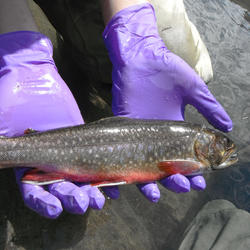Jason T. Magnuson, PhD
Dr. Jason Magnuson is a Research Biologist at the Columbia Environmental Research Center.
Dr. Magnuson researches the influence of environmental contaminants and abiotic stressors on fish health. He uses molecular-level endpoints, such as transcriptomics and metabolomics, to link to higher levels of biological organization, including histopathology, physiology, and behavior, to understand the toxicity of aquatic pollutants to fish. Previous research projects have involved the relationship between mercury and selenium molar ratios to fish stress responses, the impact of pesticides to neuroendocrine, olfactory, swimming performance, and neurotoxic responses to salmonids, the effects of polycyclic aromatic hydrocarbons present in crude oil on early life stage eye development and fish visual function, as well as the toxic response of contaminants when present as a mixture or co-exposed with ultraviolet radiation and temperature. Additionally, current research projects have focused on the impact of pharmaceuticals on early life stage fish development.
Professional Experience
2023 - present, Research Biologist, U.S. Geological Survey, Columbia Environmental Research Center, Columbia, MO
2021-2023, Postdoctoral Fellow, University of Stavanger, Stavanger, Norway
2018-2021, Postdoctoral Fellow, University of California, Riverside, Riverside, CA
Education and Certifications
Ph.D. in Biology, University of North Texas, 2018
M.S. in Biology with Aquatic Science Concentration, University of Wisconsin-La Crosse, 2015
B.S. in Biology and minor in Environmental Science, Lander University, 2013
Science and Products
Study Finds PFOSA Can Suppress Immune Function in Developing Zebrafish (Danio rerio)
Comprehensive Research on PFAS Exposomics and Risk Assessment
Fishing and Hunting Integrated Science Team
Immunotoxic response of bio-based plastic on early life stage zebrafish (Danio rerio): A safe alternative to petroleum-based plastics?
Perfluorohexanesulfonic acid (PFHxS) impairs lipid homeostasis in zebrafish larvae through activation of PPARα
Dopaminergic and anti-estrogenic responses in juvenile steelhead (Oncorhynchus mykiss) exposed to bifenthrin
Perfluorooctane sulfonamide induced autotoxic effects on the zebrafish immune system
The roles of diet and habitat use in pesticide bioaccumulation by juvenile Chinook Salmon: Insights from stable isotopes and fatty acid biomarkers
Microplastic-mediated new mechanism of liver damage: From the perspective of the gut-liver axis
Mixture effects of per- and polyfluoroalkyl substances on embryonic and larval Sheepshead Minnows (Cyprinodon variegatus)
Transcriptomic profiles of brains in juvenile Atlantic cod (Gadus morhua) exposed to pharmaceuticals and personal care products from a wastewater treatment plant discharge
Effect of florfenicol administered through feed on Atlantic salmon (Salmo salar) gut and its microbiome
Hepatotoxic response of perfluorooctane sulfonamide (PFOSA) in early life stage zebrafish (Danio rerio) is greater than perfluorooctane sulfonate (PFOS)
Non-USGS Publications**
biomarkers of oxidative stress in northern pike (Esox lucius): Toxics, v. 11, no. 3, p. 244.
https://www.mdpi.com/2305-6304/11/3/244
https://doi.org/10.1016/j.envpol.2022.119102
https://doi.org/10.1016/B978-0-12-824464-7.00014-3
**Disclaimer: The views expressed in Non-USGS publications are those of the author and do not represent the views of the USGS, Department of the Interior, or the U.S. Government.
Science and Products
Study Finds PFOSA Can Suppress Immune Function in Developing Zebrafish (Danio rerio)
Comprehensive Research on PFAS Exposomics and Risk Assessment
Fishing and Hunting Integrated Science Team
Immunotoxic response of bio-based plastic on early life stage zebrafish (Danio rerio): A safe alternative to petroleum-based plastics?
Perfluorohexanesulfonic acid (PFHxS) impairs lipid homeostasis in zebrafish larvae through activation of PPARα
Dopaminergic and anti-estrogenic responses in juvenile steelhead (Oncorhynchus mykiss) exposed to bifenthrin
Perfluorooctane sulfonamide induced autotoxic effects on the zebrafish immune system
The roles of diet and habitat use in pesticide bioaccumulation by juvenile Chinook Salmon: Insights from stable isotopes and fatty acid biomarkers
Microplastic-mediated new mechanism of liver damage: From the perspective of the gut-liver axis
Mixture effects of per- and polyfluoroalkyl substances on embryonic and larval Sheepshead Minnows (Cyprinodon variegatus)
Transcriptomic profiles of brains in juvenile Atlantic cod (Gadus morhua) exposed to pharmaceuticals and personal care products from a wastewater treatment plant discharge
Effect of florfenicol administered through feed on Atlantic salmon (Salmo salar) gut and its microbiome
Hepatotoxic response of perfluorooctane sulfonamide (PFOSA) in early life stage zebrafish (Danio rerio) is greater than perfluorooctane sulfonate (PFOS)
Non-USGS Publications**
biomarkers of oxidative stress in northern pike (Esox lucius): Toxics, v. 11, no. 3, p. 244.
https://www.mdpi.com/2305-6304/11/3/244
https://doi.org/10.1016/j.envpol.2022.119102
https://doi.org/10.1016/B978-0-12-824464-7.00014-3
**Disclaimer: The views expressed in Non-USGS publications are those of the author and do not represent the views of the USGS, Department of the Interior, or the U.S. Government.




